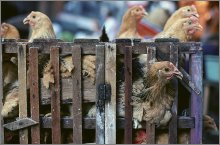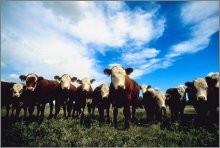From "Free Range" to "Grass Fed":
What the Popular Healthy Food Phrases Really Mean
by www.SixWise.com
Whether on a package of eggs in your grocery store or listed
on a menu in your favorite restaurant, words like "free-range,"
"grass-fed," "natural," and "organic"
are everywhere these days. Most of these labels sound quite
good and healthy, but what does it really mean when you order
"wild game" or "pasture-raised" chicken?
|

Poultry labeled "free-range" only has to
have been allowed access to the outdoors (but the space
it's allowed could be as small as a laptop computer).
|
It may not be what you think. Many food labels can be deceiving
and knowing what a food claim truly means -- and doesn't mean
-- is the only way to ensure you're getting exactly what you
had in mind. So put down that "natural" candy bar
and don't buy another "free-range" egg, until, that
is, you find out what's really behind those fancy terms.
Common Food Labels Finally Deciphered
1. Free-Range
Both eggs and poultry can be labeled as "free-range"
or "free-roaming." While this conjures up images
of hens running freely around a farm, in reality this label
can be used as long as the producers have given the poultry
"access to the outside." There is no rule as to
how long the poultry must have access to the outdoors, nor
how large the space must be (the "range" a free-range
chicken is exposed to could literally be the size of a desktop
or smaller).
2. Organic
All organic agricultural farms and products must meet the
following guidelines (verified by a USDA-approved independent
agency):
-
Abstain from the application of prohibited materials
(including synthetic fertilizers, pesticides, and sewage
sludge) for 3 years prior to certification and then continually
throughout their organic license.
-
Prohibit the use of genetically modified organisms and
irradiation.
-
Employ positive soil building, conservation, manure management
and crop rotation practices.
-
Provide outdoor access and pasture for livestock.
-
Refrain from antibiotic and hormone use in animals.
-
Sustain animals on 100% organic feed.
-
Avoid contamination during the processing of organic
products.
-
Keep records of all operations.
However, not all "organic" products are created
equal. If a product contains the "USDA Organic"
seal, it means that 95 to 100 percent of its ingredients are
organic. Products with 70 to 95 percent organic ingredients
can still advertise "organic" ingredients on the
front of the package, however, and products with less than
70 percent organic ingredients can identify them on the side
panel.
3. Natural
Be very wary of "natural" claims on labels, as
usually it can mean just about anything. The claim is only
regulated by the USDA in the case of meat and poultry, where
"natural" means no artificial ingredients or colors
have been added, and the product has been minimally processed.
When a product says "natural" be sure they define
exactly what they mean or don't be swayed by the designation.
4. Pasture-Raised
Pasture-raised poultry have been raised on a pasture where
they're able to eat grass. However, it's not typically in
a free-roaming capacity. The birds are usually raised in movable
pens that are dragged around a pasture every few days to give
access to fresh grass.
5. Grass-Fed
This means the animal was fed grass, rather than grains (which
is what most cattle are fed). However, a "grass-fed"
label doesn't mean the animal necessarily ate grass its entire
life. Some grass-fed cattle are "grain-finished,"
which means they ate grains from a feedlot prior to slaughter.
Check the fine print on the label for this important distinction.
6. Heritage
A "heritage" label describes a rare or antique
breed of livestock. These animals are prized for their rich
taste and usually contain a higher fat content than commercial
breeds.
|

Grass-fed cattle must be fed grass (rather than grains,
as most cattle are fed). But check the fine print; if
it says "grain-finished" it means the cattle
spent the latter part of their life eating grains in
a feedlot.
|
7. Wild Game
Contrary to the label, almost all "wild game" found
in restaurants is farm-raised. Farm-raised wild game tends
to have a milder flavor than truly wild game.
8. Healthy
Foods labeled "healthy" must be low in fat and
saturated fat and contain limited amounts of cholesterol and
sodium. Certain foods must also contain at least 10 percent
of one or more of vitamins A or C, iron, calcium, protein
or fiber.
9. Fat- or Calorie-Free
Foods labeled fat- or calorie-free must have none or only
a trivial amount of the ingredient (such as fewer than 0.5
g of fat and fewer than 5 calories per serving). However,
keep in mind that since many people eat more than one serving
of food, you may end up getting some fat and/or calories.
10. Fresh
The "fresh" label can only be used on food that
is raw, has never been frozen or heated, and contains no preservatives.
However, "fresh" foods can be irradiated.
11. Fair Trade
The "fair trade" label means that farmers and workers
in developing countries have received a fair wage and have
had decent working conditions while growing/packaging the
product.
12. Good Source
If a food claims to be a good source of something, say calcium,
one serving of the food must contain 10 to 19 percent of the
Daily Recommended Value for that nutrient.
Recommended Reading
So
Now What Exactly Does Certified Organic Mean? Is it Really
Organic?
Food
Nutrition Labels: Six Catches You Need to Know
Sources
U.S.
Food and Drug Administration
U.S.
Department of Agriculture
CNN.com